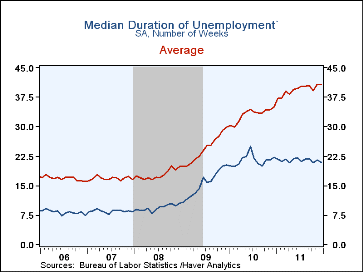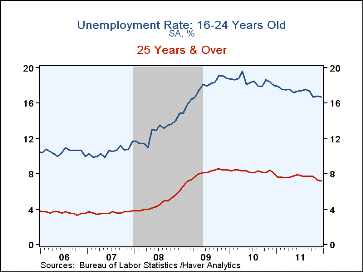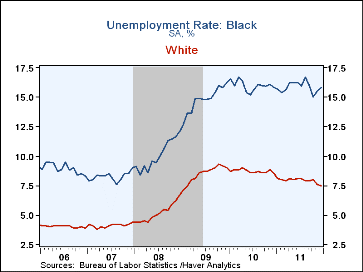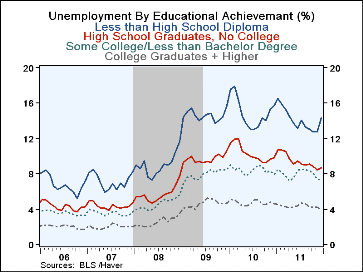 Global| Jan 11 2012
Global| Jan 11 2012U.S. Joblessness Remains Elevated by Duration, Age & Race; Higher Education Pays Dividends
by:Tom Moeller
|in:Economy in Brief
Summary
The Household Employment Survey from the Bureau of Labor Statistics indicated job market improvement last month. However, while the official unemployment rate of 8.5% was well below its October '09 high of 10.0%, the picture was not [...]
The Household Employment Survey from the Bureau of Labor Statistics indicated job market improvement last month. However, while the official unemployment rate of 8.5% was well below its October '09 high of 10.0%, the picture was not especially encouraging by another measure. Long-term unemployment showed little-to-no improvement. The percentage of individuals out of work for 52 weeks or longer slipped to 30.6% weeks. However, it remained triple the 10.5% averaged during 2008. It's the percentage of workers out of work for relatively short periods of time that fell substantially. For example, for those out of work for 15-26 weeks the rate fell last month to 15.5%, down four percentage points from 2009. The swelled ranks of the long-term unemployed in December left the median length of unemployment at 21.0 weeks. That's down from the 2010 monthly peak of 25.0% (elevated by the end of Census taking) but still well above the 8.2% low for all of 2006. However, December's average length of unemployment of 40.8 weeks was roughly the series' high.
By age, the picture of high unemployment was bleak for youths. Overall teenage unemployment for men was unchanged at 26.6%. That compares to 8.0% for those over 20 and to 7.2% for those over 25. Jobless rates for women are lower than for men. The unemployment rate for teenage females of 19.3% compares to 7.9% for those over 20 and 7.3% for those over 25. By race and age the comparison is more stark. For black or African Americans, December's 15.8% unemployment rate reflected a little-reduced 42.1% rate for teens; 48.3% rate for male teens. Overall adult black unemployment of 14.8% compared to the 2007 low of 7.3%. Black female jobless rates are roughly ten percentage points lower versus men. For whites, jobless rates are lower than for blacks. The overall unemployment rate of 7.5% was down from its 2009 monthly high of 9.3% and reflected a lessened 20.3% rate for teens and 7.0% joblessness for those 20 and over. Again, the rates for women are significantly lower than for men.
Finally, the employment figures strongly indicate the benefit of more education. For all those aged 25 & over with less-than a high school diploma, the latest 13.8% unemployment rate compared to an 8.7% rate for high school graduates, a 7.7% rate for those with some college and 4.1% for college graduates. However, it should be noted that each of these rates were roughly double the recession lows.
The unemployment figures are available in Haver's USECON and in the EMPL databases.
Recessions and the Costs of Job Loss by Steven J. Davis and Till von Wachter in the Brookings Papers on Economic Activity can be found here .
Tom Moeller
AuthorMore in Author Profile »Prior to joining Haver Analytics in 2000, Mr. Moeller worked as the Economist at Chancellor Capital Management from 1985 to 1999. There, he developed comprehensive economic forecasts and interpreted economic data for equity and fixed income portfolio managers. Also at Chancellor, Mr. Moeller worked as an equity analyst and was responsible for researching and rating companies in the economically sensitive automobile and housing industries for investment in Chancellor’s equity portfolio. Prior to joining Chancellor, Mr. Moeller was an Economist at Citibank from 1979 to 1984. He also analyzed pricing behavior in the metals industry for the Council on Wage and Price Stability in Washington, D.C. In 1999, Mr. Moeller received the award for most accurate forecast from the Forecasters' Club of New York. From 1990 to 1992 he was President of the New York Association for Business Economists. Mr. Moeller earned an M.B.A. in Finance from Fordham University, where he graduated in 1987. He holds a Bachelor of Arts in Economics from George Washington University.












